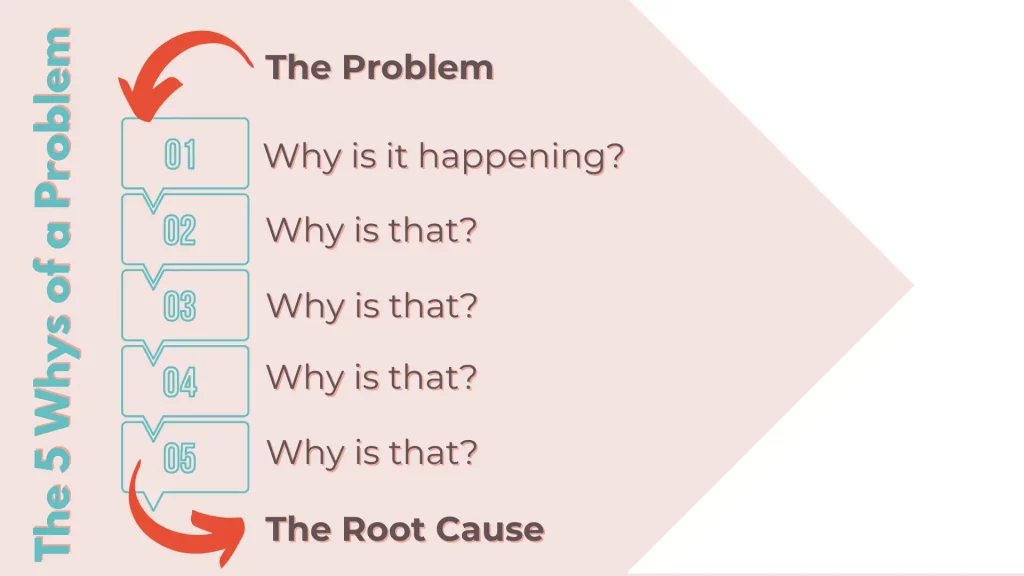“The 5 Whys” Problem Solving Lessons From Toyota
When something goes wrong in a process or project, it’s essential to understand the root cause of the problem to prevent it from happening again. This is where the 5 Why’s technique comes in. This simple yet effective approach helps identify the underlying reasons for a problem and fix it at its core rather than just addressing the symptoms. This blog will discuss the basics of the 5 Whys technique, including who developed it and how it works. We will also dive into the advantages and disadvantages of using this approach and provide a step-by-step guide on performing a 5 Why’s analysis. Lastly, we will explore when to use this technique to get maximum benefits.What is the Five Whys technique?
The Five Whys technique is a problem-solving method that involves asking “why” five times to identify the root cause of a problem. It was developed by Sakichi Toyoda, the founder of Toyota Industries, to improve the company’s manufacturing process. The Five Whys technique involves asking a series of “why” questions to identify the underlying cause of a problem. After identifying the problem, you ask “why” it occurred. The answer to that question becomes the basis for the next “why” question, and so on, until you reach the root cause of the problem. For example, if the problem is that a machine is not working, the first “why” question might be, “Why is the machine not working?” The answer might be that it is not receiving power. The second “why” question might be, “Why is the machine not receiving power?” The answer might be that the power cord is not plugged in. The third “why” question might be, “Why is the power cord not plugged in?” The answer might be that it was unplugged to use for another machine. And so on, until the root cause of the problem is identified and addressed. The Five Whys technique can be used in various settings, from personal problem-solving to organizational management. It is a simple and effective way to get to the root cause of a problem and address it meaningfully.How does it work?
Root Cause Analysis (RCA) is a problem-solving technique used to identify the underlying cause of an issue. It involves systematically analyzing possible causes until the root cause is determined. For example, the 5 Whys method is a common RCA tool that helps teams dig deep into the root cause by tracing cause-and-effect chains. To use the 5 Whys method, teams start by identifying a problem and then ask “why” until they have reached the underlying cause of the problem. This can take multiple rounds of questioning, but it helps to eliminate surface-level issues and get to the root cause of the problem. By using RCA, not only can teams identify what went wrong, but they can also develop a framework to prevent future occurrences of the issue. End-result events rarely happen in isolation; therefore, it may take several levels of questioning to work back to the actual starting point. With collective knowledge and quick response time, RCA helps extinguish problems before they become recurrent.Other Interesting Reads
Why should you use the 5 whys technique?
The 5 Whys technique is a popular tool for conducting root cause analysis. It involves asking “why” multiple times to get to the underlying cause of a problem. There are several advantages to using this technique, including the following:- Helps identify the root cause: The 5 Whys technique effectively identifies the root cause of a problem by digging deep into the underlying issues that caused the problem in the first place.
- Simple and easy to use: The technique is simple to use and requires no special training or expertise. Anyone can use it to solve problems.
- Cost-effective: The technique is cost-effective as it requires no special tools or software and can be implemented with minimal resources.
- Promotes team collaboration: The 5 Whys technique encourages team collaboration and involvement, as it requires the input and cooperation of all team members to arrive at the root cause.
What are some problems in the 5 whys technique?
While the 5 Whys technique is a valuable tool for identifying the root cause of a problem, it does have some disadvantages. One potential issue is that the technique may not uncover all root causes, and it may oversimplify complex issues. Additionally, the process relies on accurate and honest answers from participants, which may not always be accurate.- Can be time-consuming: The technique can be time-consuming, especially if the problem is complex or the root cause is not immediately apparent.
- May lead to oversimplification: The technique may lead to oversimplification of the problem, as it focuses only on the immediate causes and may overlook other contributing factors.
- Requires skilled facilitation: The technique requires professional facilitation to ensure that the right questions are asked and the discussion stays on track.
- Limited applicability: The technique may not be suitable for complex problems or those with multiple root causes, as it may not provide a comprehensive solution.
The 5 Whys Process for you
The 5 Whys is a problem-solving technique used to identify a problem’s root cause by asking “why” questions. The process involves asking “why” five times or more, each time building on the answer to the previous question until the root cause of the problem is identified.
- Identify the problem: Begin by clearly defining the problem that needs to be solved. This will help you to focus your questions on the right issue.
- Ask “why” the problem occurred: Ask why the problem occurred and identify the immediate cause. For example, if the problem is a machine breakdown, the primary reason could be a faulty part.
- Ask “why” again: Ask why the immediate cause occurred and identify the underlying cause. For example, if the primary reason is a faulty part, the underlying cause could be poor maintenance.
- Continue asking “why”: Keep asking “why” and identifying the underlying causes until you reach the root cause of the problem. This may take five or more iterations.
- Address the root cause: Once you have identified the root cause of the problem, you can take steps to address it. This may involve implementing new procedures, training employees, or changing equipment or systems.
Where can you use the 5 whys technique at work?
The 5 Whys technique can be applied to a wide range of workplace situations; here are five examples:- Equipment failures: When a piece of equipment breaks down, the 5 Whys technique can be used to identify the root cause of the problem and prevent future losses.
- Quality control issues: If a product consistently fails to meet quality standards, the 5 Whys technique can be used to identify the underlying cause and develop a corrective action plan.
- Process inefficiencies: If a process is not as efficient as possible, the 5 Whys technique can identify the root cause and find ways to streamline the process.
- Safety incidents: If a safety incident occurs, the 5 Whys technique can be used to identify the root cause and prevent future incidents.
- Customer complaints: If a customer complains about a product or service, the 5 Whys technique can be used to identify the root cause of the issue and implement corrective actions to prevent similar complaints in the future
Conclusion
The 5 Whys technique is a simple yet powerful tool that can help you identify the root cause of a problem. You can uncover and address the underlying issues by asking “why” five times. The technique has several advantages, including its simplicity and accessibility, but it also has some limitations you should be aware of. If you want to improve your problem-solving skills or implement this technique in your organization, be sure to use our comprehensive guide on the 5 Whys process.How effective are your problem solving skills?
Test your problem solving skills for free with a self-assessment for managers and team leaders.
Frequently Asked Questions
What is the 5w problem solving tool?
The 5W problem-solving tool is used to understand and define a problem by asking five basic questions: What, Who, Where, When, and Why. By answering these questions, individuals or teams can better understand the problem, identify the scope of the issue, and develop a plan to address it. The 5W tool is a simple yet effective way to approach problem-solving and decision-making.
What is the 5 W problem statement?
The 5 W problem statement is a technique used to define a problem and identify its key components. It involves asking Who, What, When, Where, and Why to create a complete picture of the problem. As a result, the problem can be more effectively analyzed and addressed by answering these questions.
What is 5W in decision-making?
5W in decision-making refers to the questions of Who, What, Where, When, and Why that are asked to gather information and better understand a situation before making a decision. These questions help to identify the problem, the people involved, the relevant information, and the timeline. By answering the 5W questions, decision-makers can make more informed and effective decisions.
Other Related Blogs
10 Signs You’re Struggling with Analysis Paralysis at Work
10 Signs You’re Struggling with Analysis Paralysis at Work The smart fox declares, “I have a hundred ways to escape when trouble approaches. You have only one.” As the dogs…
Evidence Based Decision Making: 4 Proven Hacks For Managers
Evidence Based Decision Making: 4 Proven Hacks For Managers In this blog, we will explore the concept of evidence-based decision-making and provide seven proven hacks for managers to implement evidence-based…
6 Best Books On Decision Making For Managers
6 Best Books On Decision Making For Managers Effective decision-making is crucial for managers to navigate the complexities of their roles. You are responsible for making important choices that can…
Best Decision Coaches To Guide You Toward Great Choices
Best Decision Coaches To Guide You Toward Great Choices Effective decision-making is more crucial than ever in today’s rapidly evolving business landscape. Entrepreneurs, leaders, and professionals alike are constantly faced…


